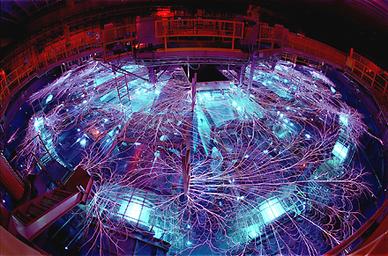And one of them taught me about something I don't even recall hearing about: orbital angular momentum.
Since I'm wicked excited to dig deep into that, I'll start with the other first.
Sandia National Labs (who inspired me greatly years ago with a picture of their Z-Machine, up top), have created a new heat sink for computers. Now, I don't know all the ins and outs of cooling computers, but apparently they use both a heat sink and a fan to cool the chips. This new heat sink is the fan, which is mighty neat. It is apparently about 30 times more efficient at dissipating heat, drawing air down through the center and shooting it out through the sides, cooling the sink in the process.
This next one uses principles I had never considered, so we're gonna try to go a little in depth on this optical madness.
The news: researchers have used 'twisted light' wireless signals to send 320 gigabytes/second (You will see everyone call it 2.5 Terabits of information, probably because it sounds so much better (welcome to the No-Sensationalism Zone)).
If you cocked your head at 'twisted' and uttered "Sa'whaaaaa?", then we should probably hang out some time.
 |
| (Courtesy FSU) |
Usually, when you get 'natural' light The photons are oriented in every which way, and it's considered unpolarized. If it bounces off of water, or goes through polarizing filters, it will lose all of the fields going in one direction, leaving it linearly polarized. Another thing you'll see above is how the peaks of the electric and magnetic fields line up. They are in phase. When they are not in phase, you do not get linear polarization, you get elliptical.
Now, I knew all about this. What I did not know was that the polarization can be twisted with something called orbital angular momentum. The elliptical (usually circular) polarization induces a spin angular momentum, not unlike the twirl of Earth on its axis. OAM is more like the Earth going around the Sun. Actually, it's orbiting a point of zero electric field called an optical vortex, which is a band name if I've ever heard one.
OAM was discovered almost accidentally about 20 years ago mathematically, as what happens when a wavefront (like light, hypothetically) has a helical (spiral) wavefront. It looks kinda like this:
Wait, sorry, more like this:
There's a plane wave in the middle for comparison. Apparently you can make a filter for producing one of these fairly easily, as described in a delightful lab experiment here:
And, and, and...oh yeah, the technology!In an effort to try a new inexpensive method we followed the recent suggestion of making a phase plate from a wedged piece of Plexiglas. We made a cut on a 1-mm thick square piece of Plexiglas (5-cm on the side), wedged the material at the cut, and passed the light through the wedged plate centered at the end of the cut, where the dislocation starts.
So, we currently manage to manipulate the spin angular momentum for data transfer, which is in the number of potential streams being sent. This twisting makes it possible, theoretically, to stuff an infinite number of modes in the same amount of space. For now, even with the eight beams they use, sending 320 gigs a second is pretty insane.
There are limitations. It will probably never be used in any sort of cable system, as any bend or kink tends to destroy the helical nature. But they managed to send it through a meter of regular ol' air, with a bandwidth efficiency of 95 bits per Hertz, which is apparently like, a batshit crazy number.
And one place that undoubtedly will be benefiting from this technology is space, with satellite-to-satellite communications, where interference is basically nil.
It's not as easy to keep progressing technologically as people might think. Just do what we used to do, but better/small/faster/denser, right? There are always always physical limitations to physical processes. That's when it takes scientific exploration and ingenuity to take the next step.




No comments:
Post a Comment